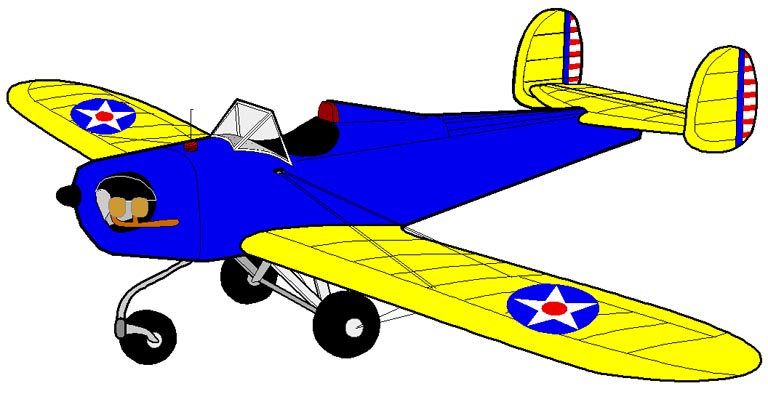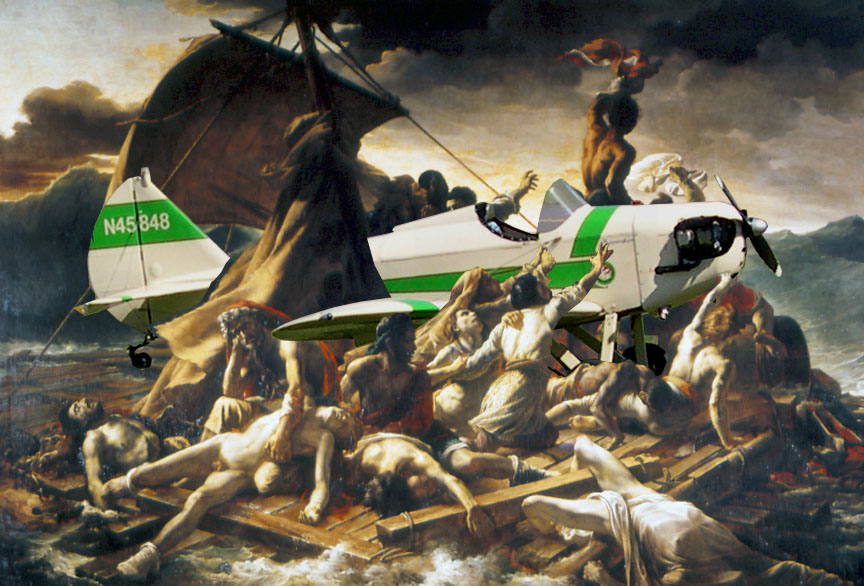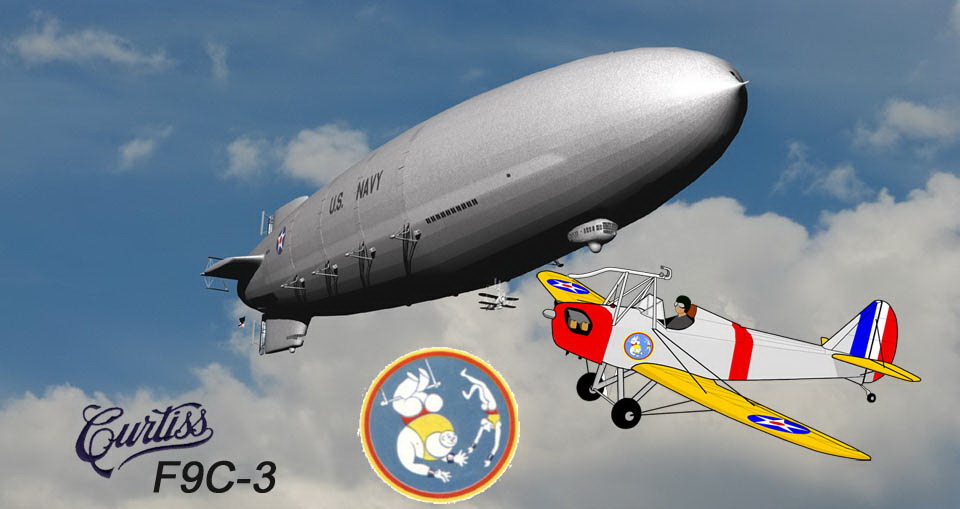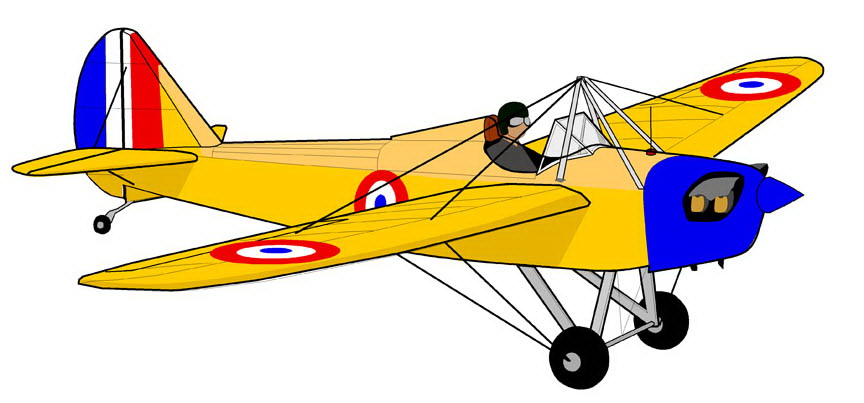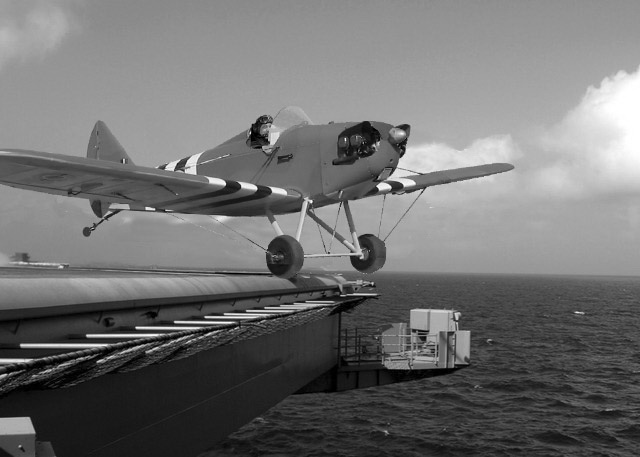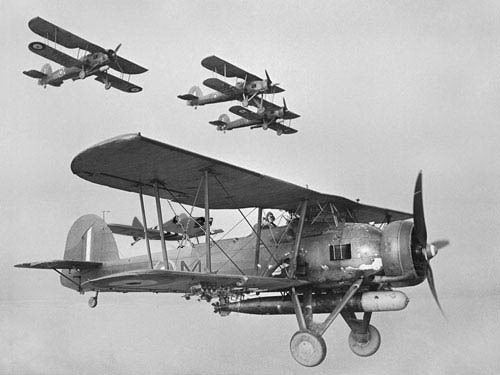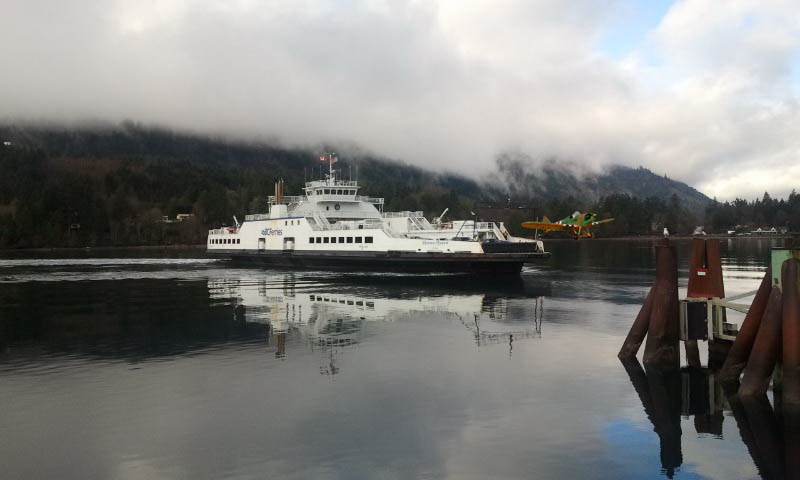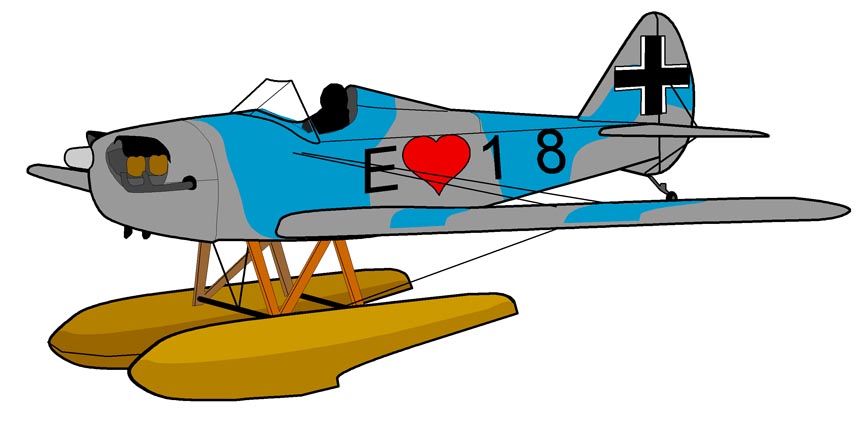Altered States: Modified Fly Baby Pictures and Fly Baby
Concepts
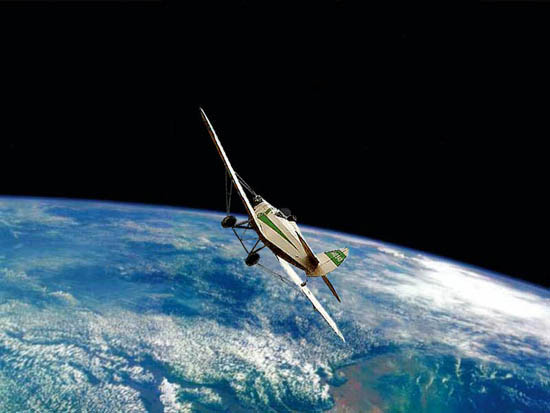 Every once in a while, I generate a...hmmm, "Non-standard" Fly Baby
picture. Or someone speculates on what a slight or major
modification might look like, and I oblige with a bit of Photoshop
magic or a new drawing. I got asked if I could publish a set
of links for my altered pictures. Instead, I just crammed them
all into a single web page.
Every once in a while, I generate a...hmmm, "Non-standard" Fly Baby
picture. Or someone speculates on what a slight or major
modification might look like, and I oblige with a bit of Photoshop
magic or a new drawing. I got asked if I could publish a set
of links for my altered pictures. Instead, I just crammed them
all into a single web page.
By the way, UNaltered fun pictures can now be found on the Slight Weird Pictures Page.
The Fly Baby 1C
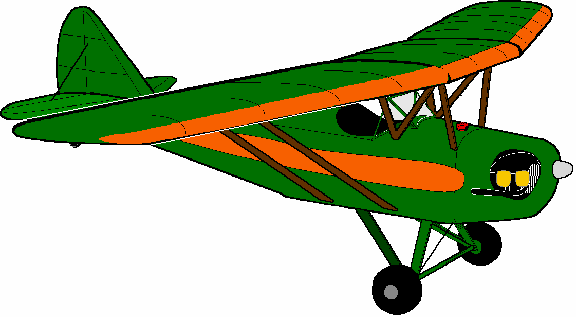 Back
in the '60s, Pete Bowers did a little thinking about the Fly Baby
model 1C. The 1A is the monoplane, the 1B is the biplane, and
the 1C would have been a parasol-winged airplane, kind of like a
Baby Ace or Pietenpol.
Back
in the '60s, Pete Bowers did a little thinking about the Fly Baby
model 1C. The 1A is the monoplane, the 1B is the biplane, and
the 1C would have been a parasol-winged airplane, kind of like a
Baby Ace or Pietenpol.
This didn't get much beyond the speculation stage. My guess
is that too much stuff had to be re-done. To allow access to
the cockpit, the plane would have needed a wing center section set
forward of the cockpit (like the biplane) and the wings swept back
to maintain the CG. But that would mean you couldn't use the
stock wings...the ribs would be crosswise to the airflow.
The 1C would have needed brand-new wings, just like the
biplane. Pete probably figured it wasn't worth the bother.
But here is an idea of what the Parasol Wing Fly Baby might have
looked like....
The Mach Busting Fly Baby
All right, I admit it: I was feeling especially goofy that
night. I had a copy of a photo of a supersonic F-14, and decided
that a Fly Baby really deserved to be in the middle of that
condensation cloud.
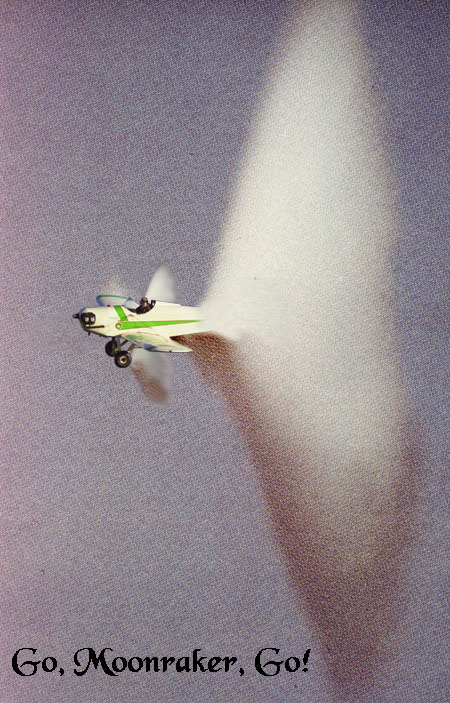
The Hurribaby
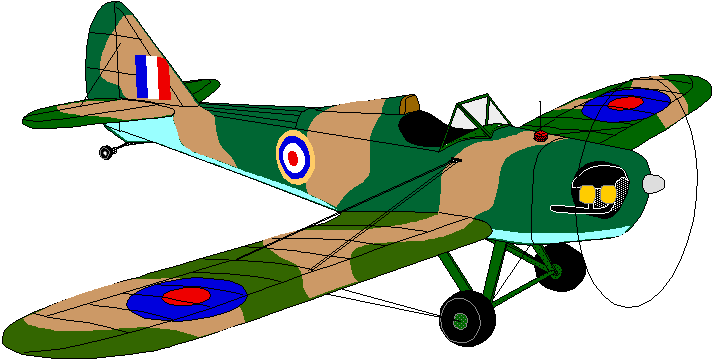
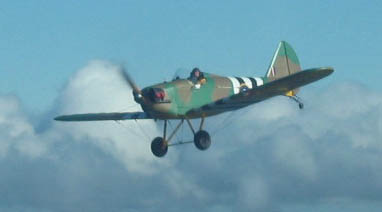 I can't help it:
I'm a sucker for military paint jobs on Fly Babies. I've
always loved the WWII British camouflage scheme, and figured I'd
give it a try on a Fly Baby. I dubbed the design the
"Hurribaby"...just to forestall those who might call it the
"Spit-Up".
I can't help it:
I'm a sucker for military paint jobs on Fly Babies. I've
always loved the WWII British camouflage scheme, and figured I'd
give it a try on a Fly Baby. I dubbed the design the
"Hurribaby"...just to forestall those who might call it the
"Spit-Up".
Interestingly, Drew Fidoe painted his Fly Baby this way. He
painted the belly yellow...that was standard British practice for
training airplane...and added D-Day invasion stripes. He
duplicated the paint job of the Miles Messenger that Field Marshal
Montgomery used. .
Even scarier, he's got an old Volkswagen Bus that he has been
driving to Fly Ins until he gets his Fly Baby finished. His wife,
Marie, will be taking over the 'Fly-In Support Chores' when Drew's
plane is ready. Marie wants the VW to match the plane, and
here's what she drew up
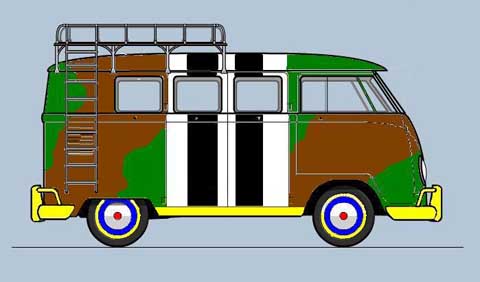
Here's how Drew's plane came out:
Doin' the Claude
I really do get a kick out of military paint jobs on Fly Babies,
especially those where the 'Baby masquerades as a non-US military
aircraft. I like the Day/Gauld-Galliers Junkers, I like Bob Grimstead's "Bristol
Balderdash."
I've been mulling over the potentials, lately. I like the
"Hurribaby" scheme, but, in all honesty, I don't really think
flying in busy airspace with camouflage paint is all that good of
an idea. Which leaves us, really with the 'tween-wars
period, so ably captured by Bob's airplane.
So: What could I shoot for? First, I'd like to try to mimic
a real aircraft. It doesn't have to look that close, but I
preferred something historical to point at. The pre-war US
Navy paint schemes were pretty nice, with yellow wings, gray
fuselages, and lavish sections of colored paint to denote the
squadrons the planes were assigned to.
I had been thinking of a mythical Curtiss F9C-3 monoplane
prototype, when my mind flashed me with a vision of another nation
that used gray and large splashes of paint on very pretty
aircraft: Japan.
It really flooded in, then. I remembered that the Flying
Tigers' first fighter adversary wasn't the Zero, but a *fixed wing
open-cockpit* fighter.
Yow. A bit of web-digging, and I found it: The
Mitsubishi A5M "Claude," the immediate predecessor to the immortal
Zero. The neat thing was, it was *very* close in
configuration to the Fly Baby (except for the radial engine, of
course).
So I had to do it. I had to do a drawing of a Fly Baby
painted up like a Claude:
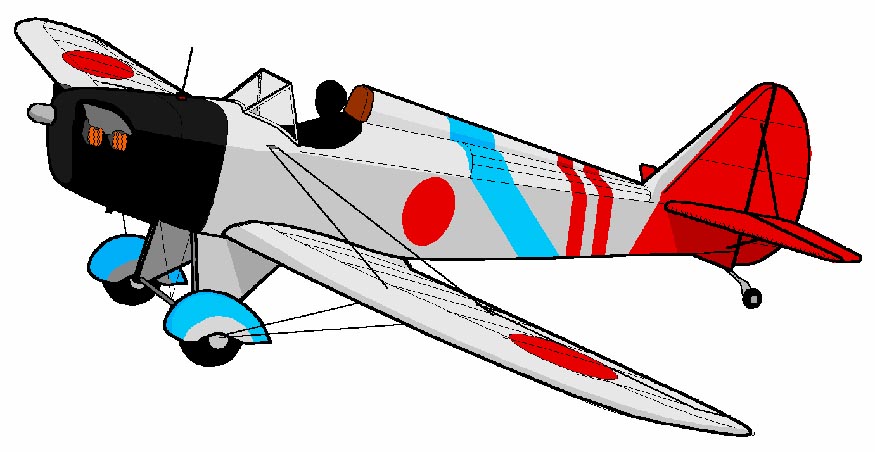
This drawing has only three cosmetic changes from the standard
airframe: Filled-in gear Vs to go with the wheel pants (to
simulate the big spats of the Claude) and a extended turtledeck.
To see a model of the "real" Claude, go to: http://www.motionmodels.com/ww2jap/claude.jpg
Gear Follies #1: Trigear
The subject of tricycle-gear Fly Babies
came up on the mailing list, and we had a bit of a discussion on the
topic. I ended up doing two drawings showing different
approaches. Here's one of them.
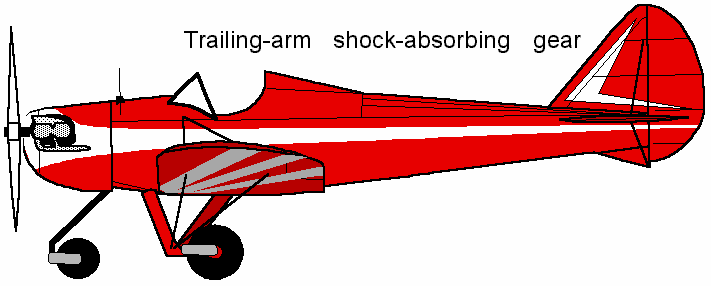
Gear Follies #2: Retractable Gear
By gum, now I've gone too far!
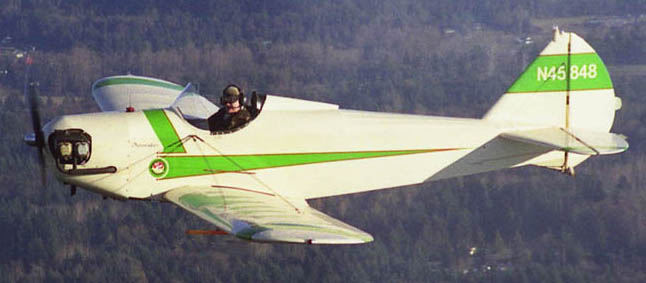
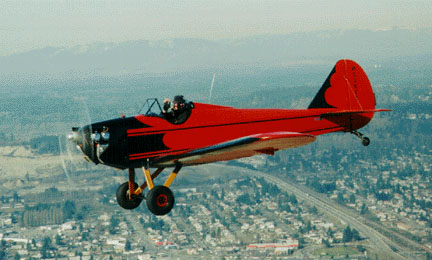 Cleaning
It
Up
Cleaning
It
Up
Cantilever wings came up on the mailing list. I personally
*like* the wires, but some people think a cleaner wing would be
better. I did this drawing to illustrate what a Fly Baby
without wing wires might look like.
By the way, here's the original picture.
Auto-Engine Conversion with Shock-Absorbing Gear
I've always thought that if my Continental gives up the ghost, I
might replace it with a Subaru. However, the Subie is heavier
than the Continental...so I did some sketches showing the cockpit
set further back for balance...and a second cockpit with a
cover. It started looking pretty racy at this point, so I
added shock-absorbing landing gear like a Ryan STA. A few
bogus RAF roundels, and you get....
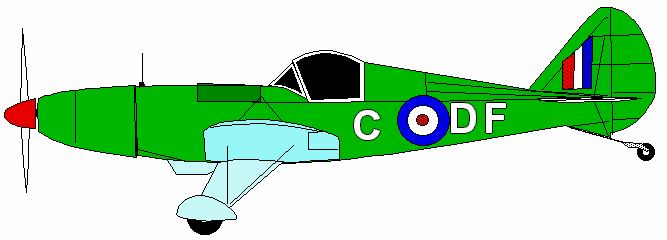
The Fun Meter
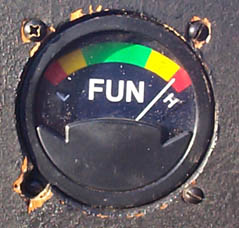 Hey, this
picture's not even fake. It's a photograph of an actual
instrument I have in my airplane.
Hey, this
picture's not even fake. It's a photograph of an actual
instrument I have in my airplane.
Building something like this is pretty simple. Just pick up an
old non-functioning gauge at a Fly Market or garage sale. Take
it carefully apart...the "face" portion of the gauge should be held
in place with just a couple of tiny screws. Measure the face
area, then draw up something on your computer using just about any
simple drawing package. Print it on your ink jet using
photo-quality paper, spray both sides with clear preservative, then
glue it onto the face plate. Reassemble the gauge, leaving out
anything that's not visible (I even ran my gauge through my band saw
to eliminate the back half of the shell).
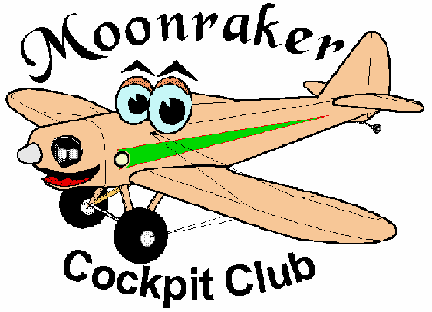 Moonraker's
Cockpit Club
Moonraker's
Cockpit Club
I'm a strong supporter of Young Eagles, and my one regret is that my
Fly Baby can't carry any. One summer, though, I noticed that
there were occasionally some sad kids who were too young to fly with
YE. I usually offered to at least let the kid sit in the
cockpit of my airplane.
I came up with "Cockpit Club" cards as a memento for these
fledglings. I used my inkjet printer and business card
stock. On one side was the logo, and on the other side was
information about my airplane...performance, size. etc.
P-26 Cosmetic Job
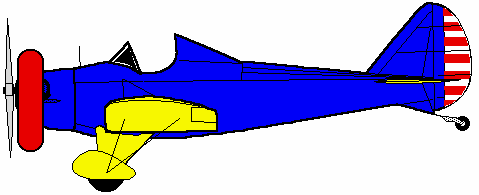 I've seen
enough guys try the pre-WWII Army Air Corps paint jobs, I figured
I'd see what could be done cosmetically to make the Fly Baby look
more like the P-26 Peashooter. The attached drawing
incorporates three minor and one major costmetic modification.
The raised turtledeck, the fabric-covered landing gear Vees, and the
wheel pants are all trivial and things that have been done
before. The only major change is the addition of a ring-shaped
fairing over the front end of the airplane to simulate the
radial-engine ring of the P-26. Not completely sure how to do
this...though it probably wouldn't take much more than a cowling
front like the Graham Lee Nieuports use....
I've seen
enough guys try the pre-WWII Army Air Corps paint jobs, I figured
I'd see what could be done cosmetically to make the Fly Baby look
more like the P-26 Peashooter. The attached drawing
incorporates three minor and one major costmetic modification.
The raised turtledeck, the fabric-covered landing gear Vees, and the
wheel pants are all trivial and things that have been done
before. The only major change is the addition of a ring-shaped
fairing over the front end of the airplane to simulate the
radial-engine ring of the P-26. Not completely sure how to do
this...though it probably wouldn't take much more than a cowling
front like the Graham Lee Nieuports use....
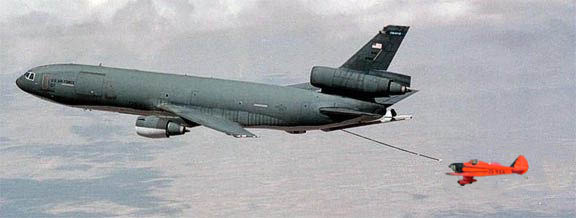 Long
Range
Fly Baby
Long
Range
Fly Baby
I'll admit it...I got the idea for this one from the RV crowd...in
fact, Renate Reeve's Fly Baby is sitting atop where an RV-4 was,
before. But since she lives in South Africa, how else is she
going to get to Oshkosh?
How to get the fuel boom past the propeller arc is a problem left
to the student....
Using Photoshop for Good, Not Evil
An ordinary Fly Baby picture, showing a dashing aviator by his
steed? I think not.
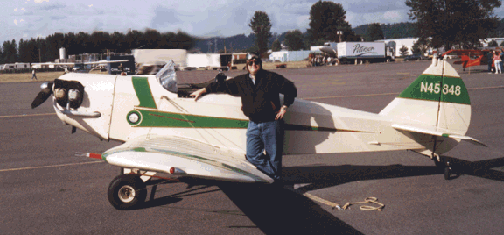
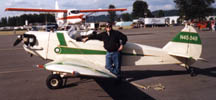 You
see, there was a little fly-in happening in the background, and it
had a great, big, DeHavilland Turbo Otter on Floats parked behind
me. It *really* distracted from the hero...uhhh, the Fly
Baby in the foreground. So I used Photoshop to delete the
Otter. That's why the tannish-colored trailer behind my
windshield looks a bit fuzzy. A small version of the
original is to the right....
You
see, there was a little fly-in happening in the background, and it
had a great, big, DeHavilland Turbo Otter on Floats parked behind
me. It *really* distracted from the hero...uhhh, the Fly
Baby in the foreground. So I used Photoshop to delete the
Otter. That's why the tannish-colored trailer behind my
windshield looks a bit fuzzy. A small version of the
original is to the right....
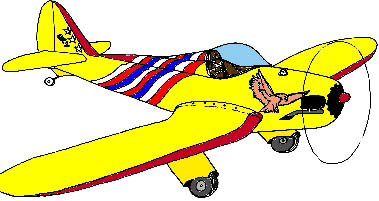 The Bent-Wing Bird
The Bent-Wing Bird
Here's one you can't blame me for. George Trepus, a friend of
Pete's from way back when, sent me this drawing of an
inverted-gull-wing Fly Baby. Says George, "Pete and I talked
about the possibility of such a variation lots of years ago. Maybe
cantilevered or possibly a center section with wire-bracing, or
both. I got busy raising a family." Pete never dropped the
idea of the bent-wing, as his two-seat Namu had the feature.
Twin-Tailed Fly Baby
OK, back to birds you can blame me for. A discussion came up
on the EAA's Oshkosh 365
forum page, asking about twin-tailed homebuilt aircraft.
Naturally (or as most people on the Fly Baby mailing list said when
they saw it, "UN-naturally"), I had to come up with a twin-tailed
Fly Baby.
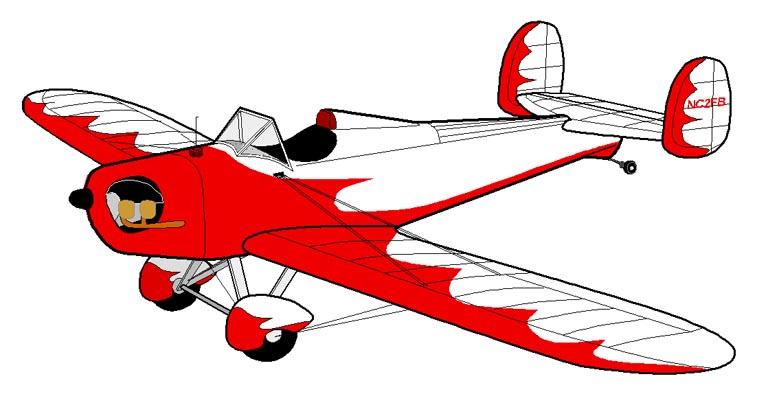
Could
it be done? Probably, but it wouldn't be quite as simple
as you might think. The stock Fly Baby tail is
wire-braced, and this would not be possible on a twin-tailed
design (the Vertical stabilizers to horizontal stab could be
wire-braced, but not the horizontal stabilizer to the
fuselage). You'd have to redesign the horizontal stab into
a cantilever design.
Just for heck, I tried a trigear version, too.... Looks a
lot like an Ercoupe, in this manifestation.
Ron's Dam Solution
There's a dam near where I live where they discovered some
unexpected deterioration. The announcement was made that
if the Seattle area got heavy rains (and, hey, it IS Seattle...)
they would have to open the sluice gates and let a bunch of
water downstream. This would could cause up to four feet
of water in a highly-industrialized valley south of Seattle.
The valley where my Fly Baby sits in its hangar....
They're supposed to give us ~8 hours warning if this was going
to happen, but if it's raining bad, it's quite possible I won't
be able to fly the plane out. The guys on the Fly Baby
mailing list got to talking about solutions. One was to
build a raft for the Fly Baby to actually sit on in the
hangar...and if the water came up, the raft would just float the
plane. We bandied this idea around a bit, but then I
realized that a classic airplane like the Fly Baby needed a
classic raft design to go with it...
Curtiss Sparrowhawk
Even before my knee started getting bad, it was kind of a pain to
lift myself out of the cockpit. Years ago, I contemplated
building a set of biplane wings, just so I could have something
above me to hang onto and hoist me out of the cockpit.
But I loved the monoplane configuration.
Install just the center section? Naw, it'd look TOO weird.
What I needed was an excuse to mount some sort of structure above
the cockpit. But what kind of plane had that?
Then it hit me: The Curtiss F9C-2 Sparrowhawk.
The F9C was a small biplane designed to operate from the US Navy's
two dirigible aircraft carriers, the Akron and the Macon. The
top wing was attached directly to the top of the fuselage, and a big
hook was installed above the cockpit. A long rail extended
forward from the hook. The dirigible would drop a trapeze
below its hangar, and the Curtiss would come up underneath and hook
on. The fighter would then stop its engine, and the dirigible
would pull the plane up into its internal fighter bay.
(There's a cable channel that runs the old movie "Dirigible", with
great footage of this process).
But the Fly Baby is a monoplane, not a biplane like the F9C-2?
Well, simple: The Fly Baby can become the un-built follow-on
to the biplane Sparrowhawk: The Curtiss F9C-3!
Morane
Another suggestion for a grip was to add a Cabane structure above
the fuselage, like a lot of WWI monoplanes. I've got a separate page on this one....
Photoshopping Drew's "Stringbag"
Drew Fidoe made baaaaad mistake a couple of years
back. He sent me a very good picture of his
recently-restored Fly Baby. The picture was of the whole
airplane, at an attractive angle, well-lit.
What's bad about that, you ask? Well...it just lends itself
TOO well to Photoshopping. Couple that with the airplane's
WWII paint job, it's nickname "Stringbag" after the famed British
Fairey Swordfish torpedo plane, Drew's status as a retired
Canadian Navy Petty Officer, and his current job...well, the
temptation was too much.
Of COURSE, Stringbag had to be showing taking off from a carrier,
on the way to attack Taranto!
Swordfish are famed for crippling the German battleship Bismarck,
allowing the British fleet to catch up and sink it. Here's
Drew escorting the mission:
The bravest pilots of WWII were those flying the Catapult
Aircraft Merchantmen fighters. Catapults were installed on
ordinary merchant ships that would let them fling a fighter aloft
to defend against attacking German bombers. There was no way
to land these fighters... the pilots had to ditch, and hope to be
picked up before they drowned or froze.
History says they used Hawker Hurricanes for this task...but
maybe there was a Stringbag, too....
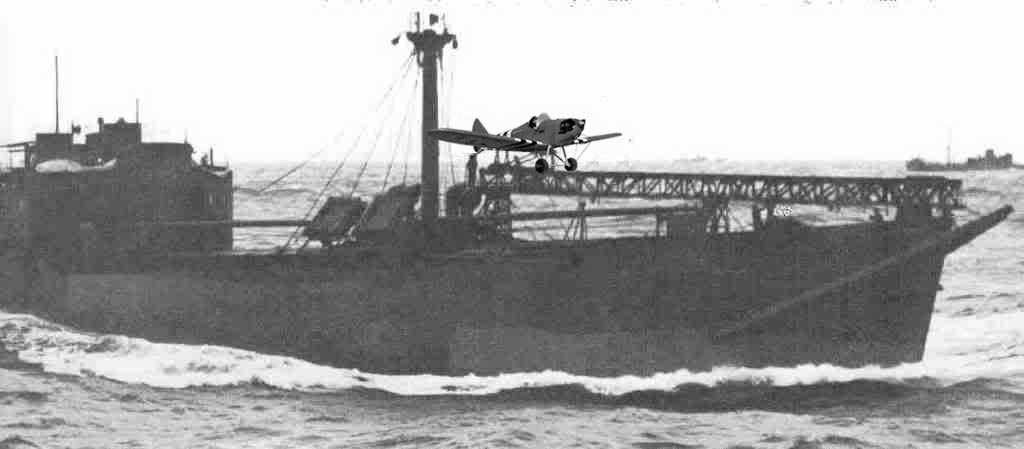
Stringbag over the Falaise Pocket, August 1944
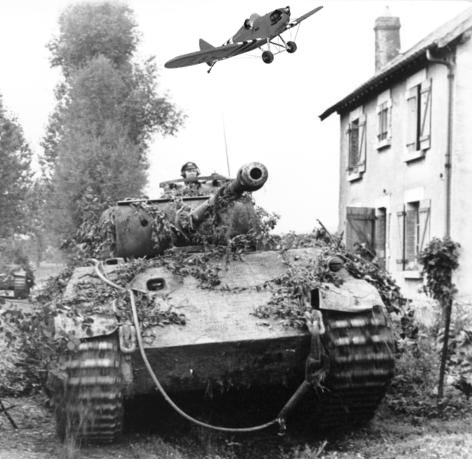
Finally...Drew's current job is as a Chief Engineer on a
ferry. We found out how he commuted to and from work....
Iron Crosses
Fly Baby builders have a tendency towards military paint
jobs. Occasionally, when someone builds a Fly Baby
biplane, they even use a German WWI paint scheme.
Had some interesting discussion about two such variants...and, of
course, they generated some pictures. The first was a Fly Baby
on floats, with a Kriegsmarine (Navy) paint job:
The second was even more interested. One potential builder
wanted to use "faux Junkers" effect
on a Fly Baby biplane... to have a two-seat German biplane!
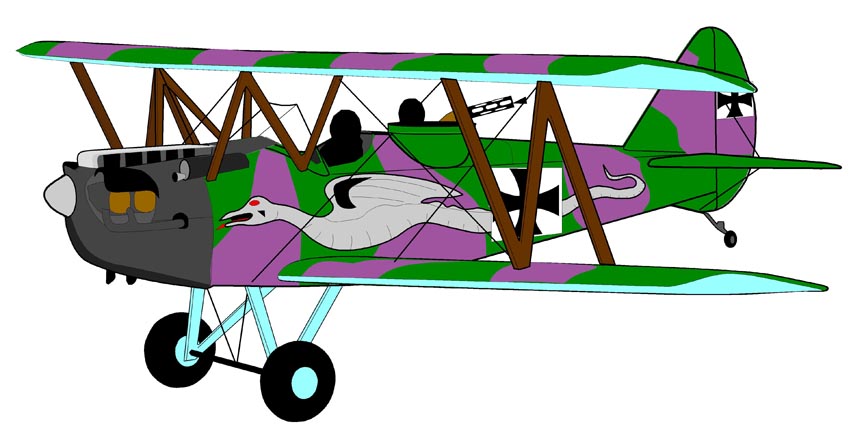
Discussion of these German configurations,
coupled with the
Morane mod discussed
earlier, led to some speculation about a replica German
"Taube."
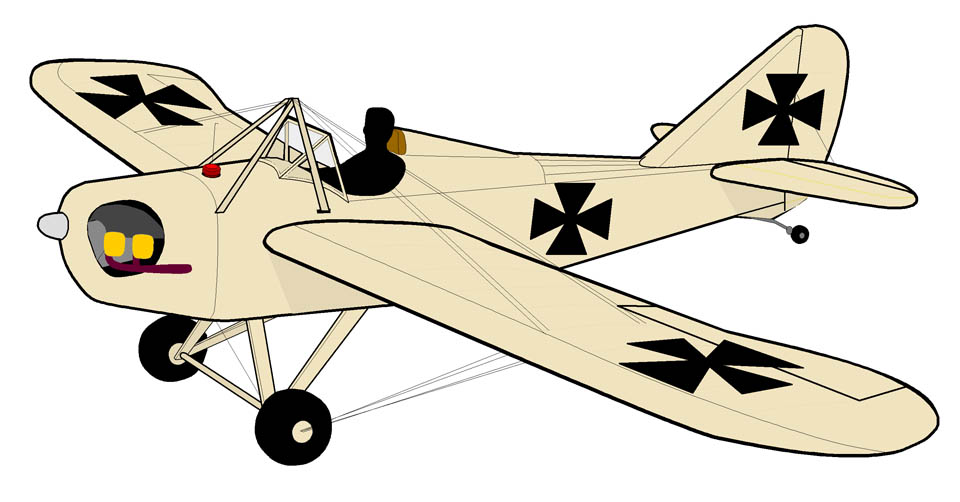
My drawing skills kind of failed on trying
to duplicate the Taube's extended ailerons, though....
A German Roscoe?
"Roscoe," our Fly Baby mascot, is generally viewed as
staunchly standing on the Allied side. However, one
can speculate whether his German cousin "Rosco" might appear
on the planes with the Maltese Crosses...
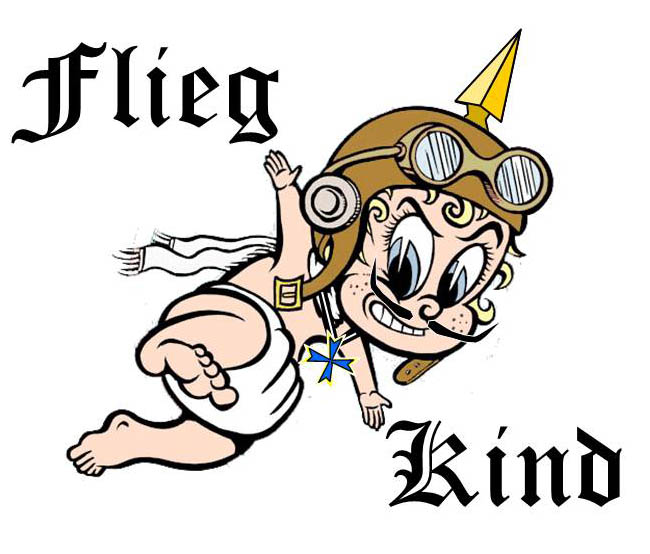
Space Fly Baby?
Boeing's X-37B Space Plane isn't that
much bigger than a Fly Baby. It's kind of the Fly
Baby of spacecraft....just room for one guy.
Hmmmmm......
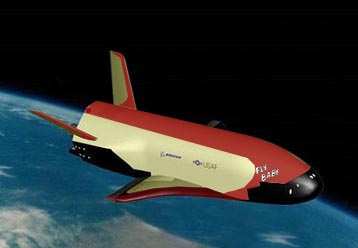
Gee Bee?
Gee Bee paint schemes have been popular on Fly
Babies, but have you ever wondered what one would look
like with a small radial engine?
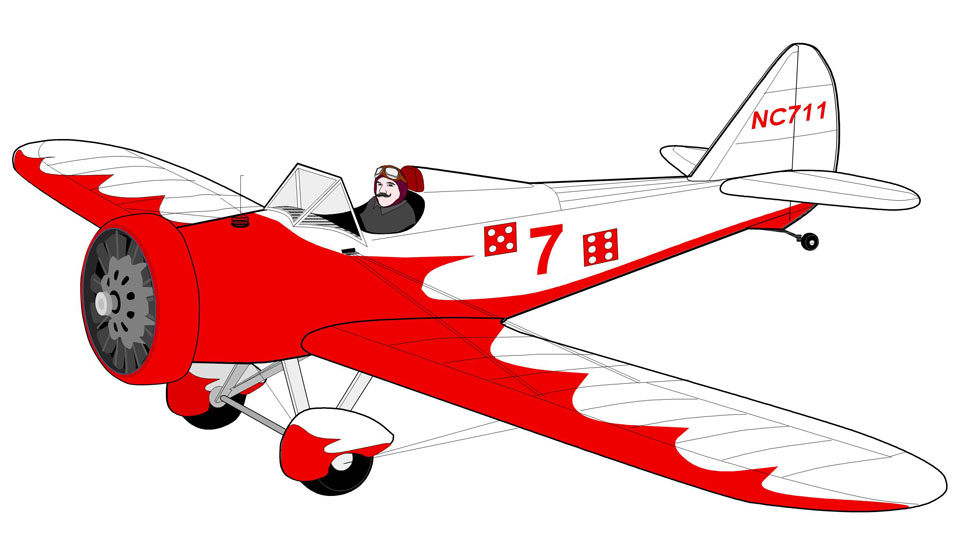
A Metal Fly...Ahhh, open-cockpit airplane?
OK, we were discussing how one could build a MODERN Fly
Baby. Aluminum construction was suggested. Then I got
to thinking...why not adapt a current design?
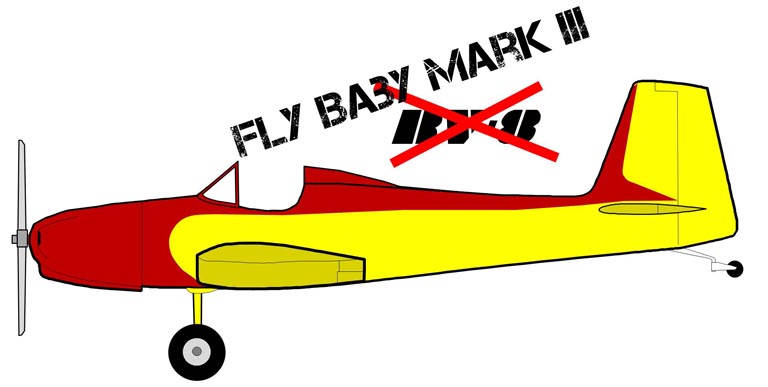
Drew and the Hucks Starter

Bill Hills and the Battle of Britain
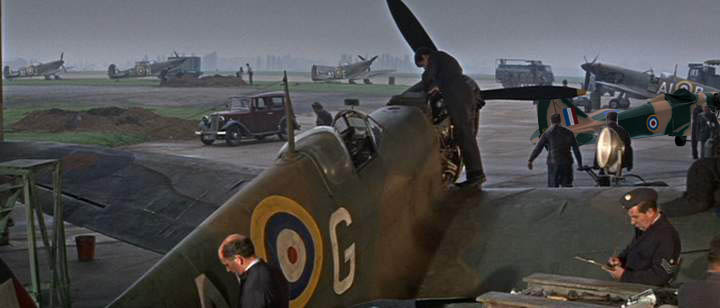
Another On-Orbit Shot

Turnabout is Fair Play
The Boeing P-26 "Peashooter" has inspired the paint jobs for
numerous Fly Babies. There's an outfit in Washington
state that's about to build some full-scale P-26
replicas...occurred to me that painting one like a Fly Baby
would be only fair.
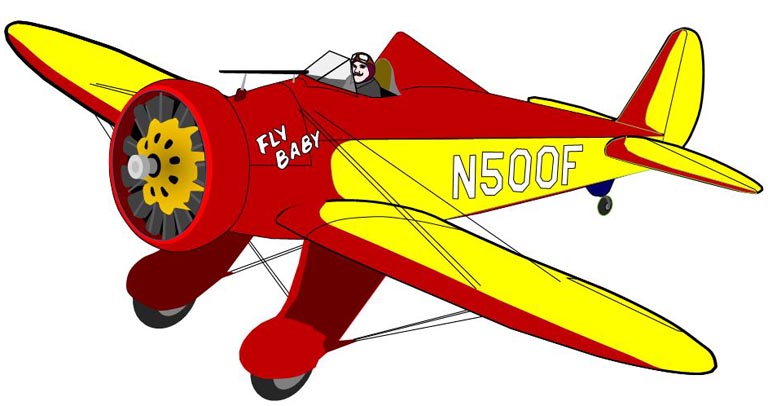
Invoking the Demon
One of our happy crowd likes to think about "Boche Baby"
versions of the Fly Baby biplane. Recently, he suggested I
look at what could be done to emulate the Hawker Demon, a
'20s-era two-seat biplane fighter that was adapted from the
Hawker Hart.
There are basically two distinguishing feature of the
Demon... the classic Hawker vertical stabilizer, and an odd "notch" type bay for the gunner.
The Hawker (e.g. DeHavilland) tail is relatively simple; the
basic structure would stay the same, and a built-up leading
edge get a bit of convexity to invoke the shape of the
original.
The gun position is tougher. The "Boche Baby" gun tub goes
atop an intact aft fuselage but the Demon has that rather
large "notch."
This is a big, draggy hole to be adding behind the pilot
seat. I'd be concerned about turbulence, and potential
blanking of the vertical stabilizer. One *might* be able to
mitigate that with careful design of the dummy that goes into
the position. Maybe.
Ideally, one could design a cover for that aft pit that covers
the notch for non-demonstration flying (non-Demon flying. Ha!).
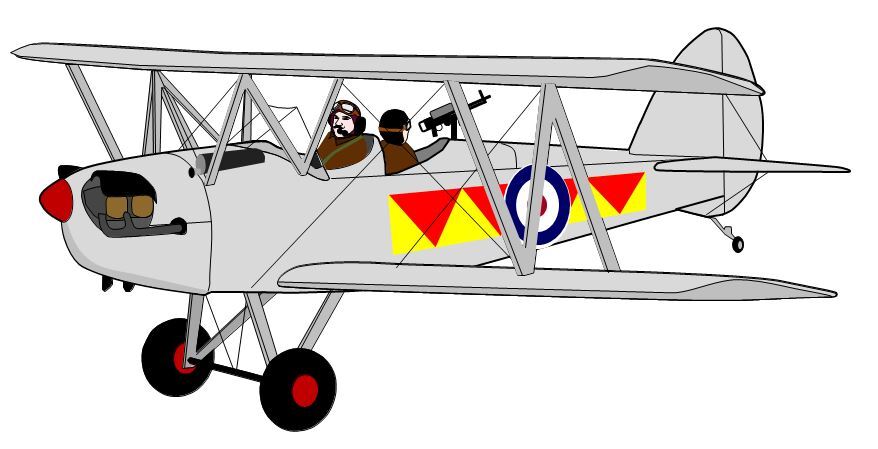
One interesting tidbit is that this *might* work as a an actual
two-seater. If the guy in the rear seat sits backward, the
CG impact isn't as bad as a forward-facing seat.
Would have to work the CG calculations pretty heavily to verify
this. Also making sure the elevator walking beam can't
isn't blocked and the elevator cables cannot be interfered with
is left as an exercise for the student.
Release that Tiedown!
We were discussing hand-propping, and one of the Fly Baby
Facebook page members posted that he tied a rope to his car to
hold the airplane while starting. This led to some
speculation on what might happen if the rope wasn't
released....
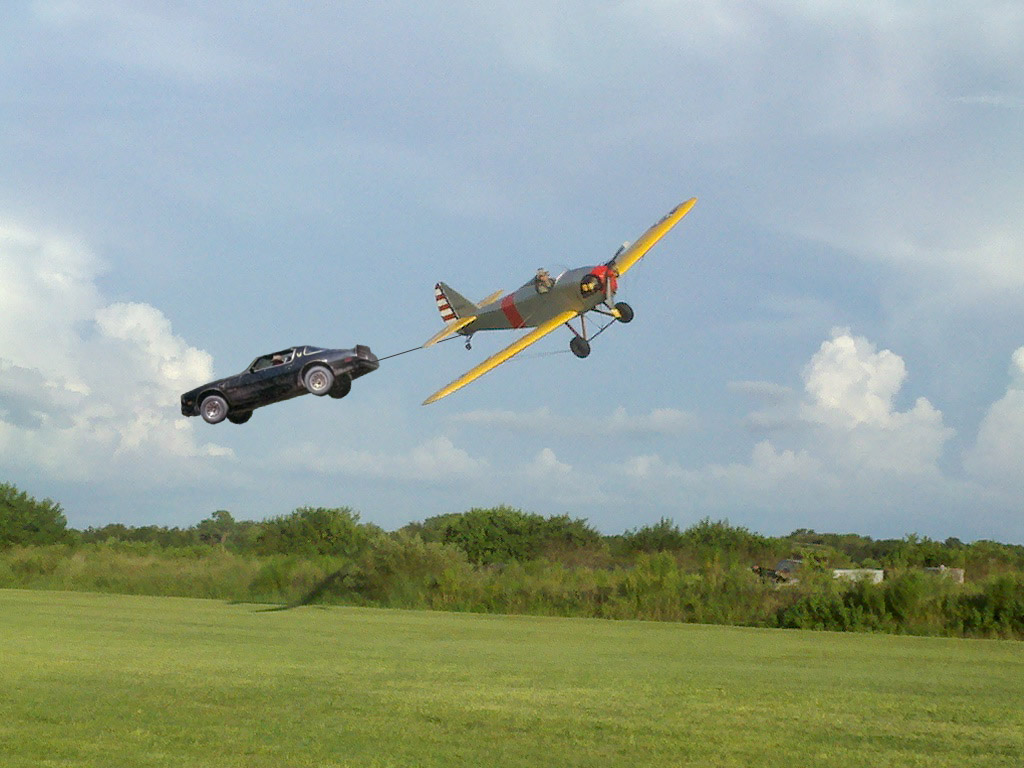
High Altitude Fly Baby?
During WWII, the British modified Spitfires for the
Photographic Reconnaissance Unit (PRU). The PRU planes
were modified for altitude work including a distinctive
light-blue paint jog. They often removed the guns as
well..
One of my EAA chapter members is building an RV-7 and giving
it a PRU paint job. Wondered what it would look like on
a Fly Baby....
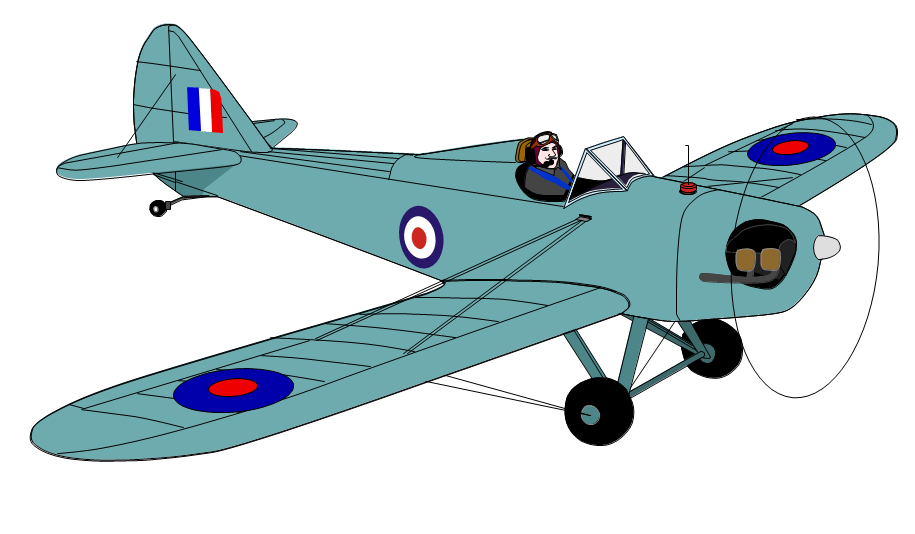
Comments? Contact Ron
Wanttaja.
 Return to The Stories Page
Return to The Stories Page
 I can't help it:
I'm a sucker for military paint jobs on Fly Babies. I've
always loved the WWII British camouflage scheme, and figured I'd
give it a try on a Fly Baby. I dubbed the design the
"Hurribaby"...just to forestall those who might call it the
"Spit-Up".
I can't help it:
I'm a sucker for military paint jobs on Fly Babies. I've
always loved the WWII British camouflage scheme, and figured I'd
give it a try on a Fly Baby. I dubbed the design the
"Hurribaby"...just to forestall those who might call it the
"Spit-Up".

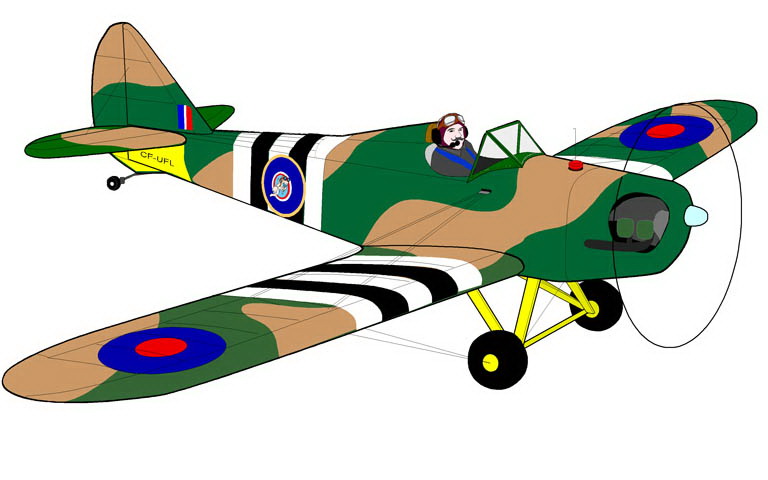

 Long
Range
Fly Baby
Long
Range
Fly Baby
You
see, there was a little fly-in happening in the background, and it
had a great, big, DeHavilland Turbo Otter on Floats parked behind
me. It *really* distracted from the hero...uhhh, the Fly
Baby in the foreground. So I used Photoshop to delete the
Otter. That's why the tannish-colored trailer behind my
windshield looks a bit fuzzy. A small version of the
original is to the right....
 The Bent-Wing Bird
The Bent-Wing Bird
